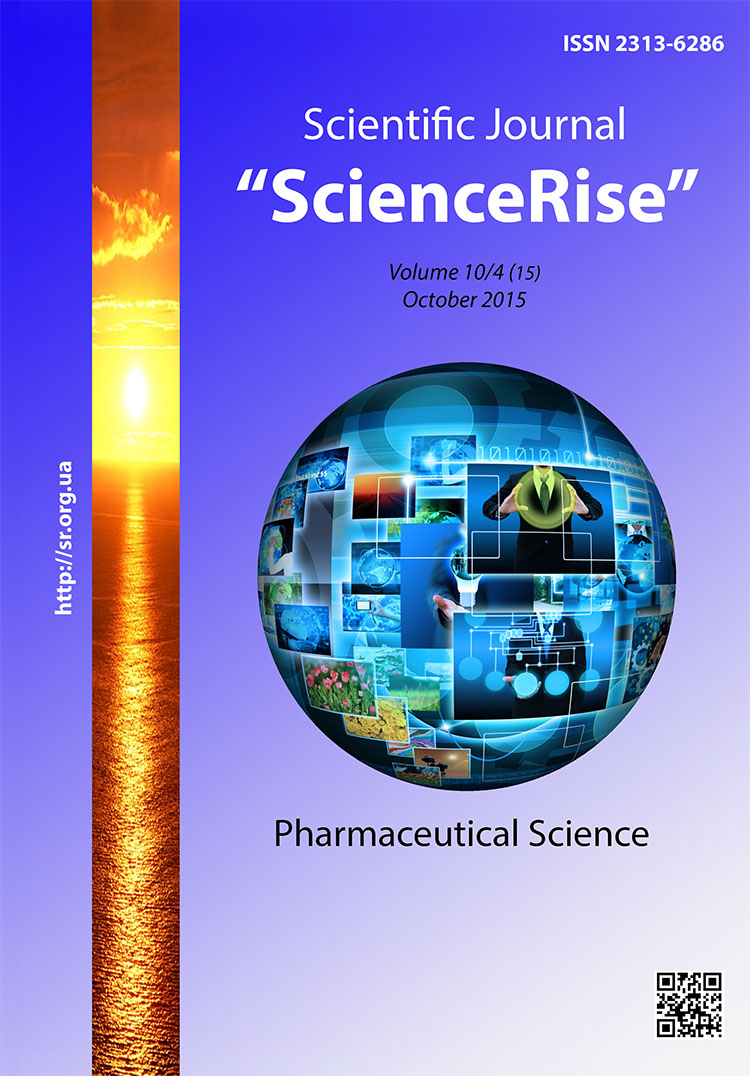Study of pharmacological activity of solid extracts of thlaspi arvense and onobrychis arenaria on a model of benign proctatic hyperplasia of rats
DOI:
https://doi.org/10.15587/2313-8416.2015.52263Keywords:
benign prostatic hyperplasia, male rats, solid extract of Thlaspi arvense, solid extract of Onobrychis arenariaAbstract
The benign prostatic hyperplasia (BPH) is the most wide spread urologic pathology of men of "gold" reproductive age, and preventive care and treatment of BPH is an issue of acute importance for urologists and andrologists of the whole world. Research of the last decade let to say about obvious tendency of this disease progression, that is caused by rise of a menhood rate of the elder age groups. The range of medicines for the treatment of prostatic diseases, presented at the world market, is quite various but an issue of universal prostatic protectors search and involving into clinical practice is still a topic one. A special place in treatment of BPH is for phytopreparations because of their low toxicity, high effectiveness, multittop of pharmacodynamics, that allow to run treatment individually, to minimize risk of sequela, to improve the quality of patients life.
In the article, results of study of pharmacological activity of solid extracts of Thlaspi arvense and Onobrychis arenaria are presented as of new prospective phytoprostatic protectors.
Goal: Pharmacological study of activity of extracts of Thlaspi arvense and Onobrychis arenaria as prostatic protectors on a model of benign sulpiride-induced prostatic hyperplasia of rats.
Methods: estimation of pathology development and pharmacological effectiveness of examined preparations was conducted based on clinical, biochemical indicators of blood plasma and prostatic homogenate.
Results: the research confucted has shown that the solid extract of Thlaspi arvense in a dosage of 100 mg/ kg and of Onobrychis arenaria in dose of 40 mg/kg can renovate sensivity of prostate cells to androgens, to neutralize processes of membrane distruction, to normalize prooxidant and antioxidant balance of rats.
Conclusions: medical intragastrical injection of a solid extract of Thlaspi arvense in a dosage of 100 mg/kg and of Onobrychis arenaria in dose of 40 mg/kg leads to renovation of prooxidant/antioxidant balance, normalizes hormon state of males rats and is not enferior in effectiveness to the comparative preparation Prostaplant Forte in a dosage of 35 mg/kg
References
Tyuzikov, I. A., Kalinchenko, S. Yu., Vorslov, L. O. (2013). Mesto androgennogo deficita v klinicheskom portrete sovremennogo urologicheskogo pacienta [A place of androgen deficiency in a clinical portrait of the modern urological patient]. Andrology and genital surgery, 3, 48–57.
Lee, S. S., Yang, Y. W., Tsai, T. H., Kuo, Y. H. et. al (2015). 5-alpha-reductase inhibitors and the risk of diabetes mellitus: A nationwide population-based study.Prostate. doi: 10.1002/pros.23097
Cindolo, L., Pirozzi, L., Sountoulides, P., Fanizza, C., Romero, M., Castellan, P. et. al (2015). Patient’s adherence on pharmacological therapy for benign prostatic hyperplasia (BPH)-associated lower urinary tract symptoms (LUTS) is different: is combination therapy better than monotherapy? BMC Urology, 15 (1). doi: 10.1186/s12894-015-0090-x
Li, S., Kwong, J. S. W., Zeng, X.-T., Ruan, X.-L., Liu, T.-Z., Weng, H. et. al (2015). Plasmakinetic resection technology for the treatment of benign prostatic hyperplasia: evidence from a systematic review and meta-analysis. Scientific Reports, 5, 12002. doi: 10.1038/srep12002
Zou, Y., Sun, Q., Li, J., Yang, C., Yang, J., Zhang, L. (2014). Effects of E/Z isomers of lycopene on experimental prostatic hyperplasia in mice. Fitoterapia, 99, 211–217. doi: 10.1016/j.fitote.2014.09.013
Van Coppenole, F., Bourhis, X. L., Carpentier, F., Delaby, G., Cousse, H., Raynaud, J.-P. et. al (2000). Pharmacological effects of the lipidosterolic extract of Serenoa repens (Permixon) on rat prostate hyperplasia induced by hyperprolactinemia: comparison with finasteride. The Prostate, 43 (1), 49–58. doi: 10.1002/(sici)1097-0045(20000401)43:1<49::aid-pros7>3.0.co;2-j
Cindolo, L., Pirozzi, L., Fanizza, C., Romero, M., Tubaro, A., Autorino, R. et. al (2015). Drug Adherence and Clinical Outcomes for Patients Under Pharmacological Therapy for Lower Urinary Tract Symptoms Related to Benign Prostatic Hyperplasia: Population-based Cohort Study. European Urology, 68 (3), 418–425. doi: 10.1016/j.eururo.2014.11.006
McConnell, J. D., Roehrborn, C. G., Bautista, O. M., Andriole, G. L., Dixon, C. M., Kusek, J. W. et. al (2003). The Long-Term Effect of Doxazosin, Finasteride, and Combination Therapy on the Clinical Progression of Benign Prostatic Hyperplasia. New England Journal of Medicine, 349 (25), 2387–2398. doi: 10.1056/nejmoa030656
Roehrborn, C. G., Siami, P., Barkin, J., Damião, R., Major-Walker, K., Nandy, I. et. al (2010). The Effects of Combination Therapy with Dutasteride and Tamsulosin on Clinical Outcomes in Men with Symptomatic Benign Prostatic Hyperplasia: 4-Year Results from the CombAT Study. European Urology, 57 (1), 123–131. doi: 10.1016/j.eururo.2009.09.035
Füllhase, C., Chapple, C., Cornu, J.-N., De Nunzio, C., Gratzke, C., Kaplan, S. A. et. al (2013). Systematic Review of Combination Drug Therapy for Non-neurogenic Male Lower Urinary Tract Symptoms. European Urology, 64 (2), 228–243. doi: 10.1016/j.eururo.2013.01.018
Downloads
Published
Issue
Section
License
Copyright (c) 2015 Алексей Викторович Андрияненков

This work is licensed under a Creative Commons Attribution 4.0 International License.
Our journal abides by the Creative Commons CC BY copyright rights and permissions for open access journals.
Authors, who are published in this journal, agree to the following conditions:
1. The authors reserve the right to authorship of the work and pass the first publication right of this work to the journal under the terms of a Creative Commons CC BY, which allows others to freely distribute the published research with the obligatory reference to the authors of the original work and the first publication of the work in this journal.
2. The authors have the right to conclude separate supplement agreements that relate to non-exclusive work distribution in the form in which it has been published by the journal (for example, to upload the work to the online storage of the journal or publish it as part of a monograph), provided that the reference to the first publication of the work in this journal is included.

